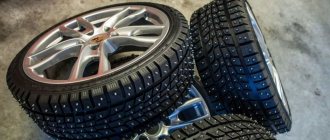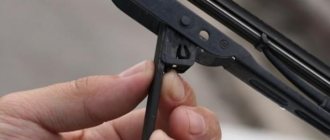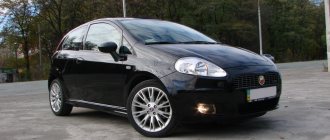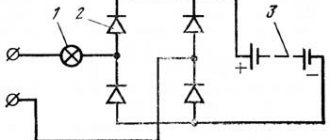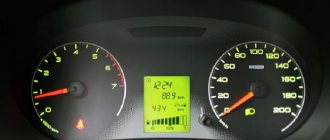How to properly install tires with asymmetric tread pattern
Directional tires can only be mounted in one position on a machine.
This is argued by the unique structure of the tread. However, some users are not aware that there are rules for installing asymmetrical tires. This type of design can operate in both directions without significant impact on driving performance. However, some tires require side alignment. Products with solid tracks must be installed with the monolithic part facing outwards - this improves control stability and traction in corners.
The peculiarity is caused by different rigidity. The inner side is soft, the outer side is made harder to hold the car on turns and improve directional stability.
Some manufacturers provide special instructions on how to properly install them on a vehicle.
Instructions for installing asymmetrical tires on a car
The requirement to comply with the rules for installing asymmetric tires is justified by the special design of the tread. External units differ from internal ones; if installed incorrectly, they can interfere with control or impair road traction. There is also excessive noise - the blocks of some models are slightly piled up in the direction of travel, which minimizes the acoustic effect and rolling resistance.
The rules for installing asymmetric tires for passenger cars and trucks imply compliance with the basic requirements:
- choice of paired wheels when purchasing;
- compliance with markings.
An important criterion is the choice of exactly matching models. If you install a decoupler on one axle, there is a possibility of incorrect behavior of the car.
The photo shows an example of how to correctly install asymmetrical wheels on a car.
Which side should you put asymmetrical tires on?
According to the installation regulations, each tire model has corresponding markings indicating the correct direction of the tread during installation.
The standard notation looks like:
- Inside (Side Facing in) – internal part;
- Outside (Side Facing out) – outer side.
When purchasing, you must install the wheels correctly and take into account the markings. To do this, just carefully examine the sidewalls of the tires.
Installation of winter asymmetric wheels
If you intend to install winter tires on your car's rims, the sequence of actions and installation method do not differ from the summer options. There are similar markings and variable tread stiffness.
How to install Viatti Strada Asymmetric tires correctly
The popular manufacturer Viatti produces a large number of summer and winter tires. However, among the assortment, the modification that stands out the most is the Strada Asymmetrico. The version requires correct installation and does not work adequately if the instructions are not followed.
To determine the required side, the code “Outside” is applied here. This inscription should be on the outside of the car.
Winter tires
Viatti winter tires are presented in a wide range of tires with increased grip on ice and snowy roads, which allows you to choose an individual and optimal option for comfortable driving in winter.
- Bosco Nordico V-523 were developed by the joint efforts of Russian, German and Spanish scientists and showed very good results on Russian roads. Features an asymmetrical projector pattern with a solid center rib and wide stud placement. VRF technology was used during production. It is thanks to this that they easily adapt to even the worst surfaces.
- Brina V-521 was developed using VRF technology specifically for winter city roads, where in winter the roads are predominantly covered with snow porridge at temperatures from - 40 to + 10. This model is a tubeless pneumatic tire with an ideally positioned inclination angle of flow grooves to remove moisture and snow. wt.
- Brina Nordico V-522 is the optimal solution for any terrain and surfaces. The model was developed taking into account Scandinavian production traditions even for the most extreme winter. They have functional blocks in the middle part and additional rows of spikes along the edges. The beveled corners of the shoulder areas of the projector are able to quickly get rid of melted snow, and frequently spaced lamellas and elastic checkers provide high adhesion to slippery and snow-covered surfaces.
- Bosco S/T V-526 are non-studded winter tires with a rigid rib, special longitudinal rows and recesses in the shoulder blocks. During testing, this model has proven itself to be an ideal option for crossovers in warm winter conditions and big cities.
- Vettore Inverno V-524 have been developed for various winter conditions for small cargo transport. The model was developed using a unique technology combining ViaMix and ViaPro rubber and is equipped with fourteen rows of studs, wide grooves and reinforced blocks. Thanks to this development technology, this model not only provides reliable handling on snowy and icy roads, but also reduces fuel consumption.
- Vettore Brina V-525 is a non-studded winter tire designed for use in warm winter conditions for various types of commercial vehicles. The model has four wide longitudinal grooves and pointed edges of the central cups. Excellent braking and stability on snowy roads are provided by a center rib and multi-directional sipes.
What winter tires are there?
Initially, for many decades, there were no winter tires on the domestic market, and most car owners installed universal all-season models on their cars, which did not provide adequate grip on slippery roads. Today on sale you can find special tires that are made of a heavy-duty compound, have a pattern that provides excellent grip on the road, or special studs that are especially good when operating a car on bare ice.
Studded winter tires are predominantly directional; accordingly, it is necessary to take into account their direction and tread pattern when installing them on a car. But studless winter tires have a special tread pattern, and thanks to its asymmetrical direction, such tires are not demanding on the direction of movement, and accordingly they can be installed on the car at will.
The debate about which winter tires are better, studded or non-studded friction tires, has not subsided for many years. Some car owners claim that studded tires perform best on Russian roads, which are equally good on bare ice and snowy surfaces. But winter friction non-studded tires can be classified as universal, which allows them to be used on vehicles of various types and on surfaces with different grip characteristics. These studless winter wheels are equally good both on bare asphalt and on slippery roads.
Main characteristics of the Viatti V 522 model
The Viatti brand appeared on the market in 2010 and immediately established itself as a supplier of quality tires in the mid-price segment. The company's products comply with European standards and are distinguished by their adaptation to the not always ideal state of domestic roads.
The Brina Nordico line of winter tires was produced specifically for the changeable winter conditions of the middle zone. It combines the properties of friction Velcro and classic studded rubber.
Winter tires Viatti v 522 have the following features:
- confident movement on icy surfaces thanks to factory studs;
- tread structure that prevents slipping on wet snow;
- reinforced sidewall that protects the tire from cuts;
- good cross-country ability on high and loose snow thanks to powerful blocks in the shoulder area;
- maneuverability and controllability provided by variable stiffness technology (VRF).
Reviews from owners of winter tires Viatti V 522
Contents
Regardless of seasonality of use, all modern tires are divided into three main types according to their tread pattern:
- Non-directional.
- Directional symmetrical.
- Directional asymmetrical.
Each of these types has features of installation and use. The easiest way to determine the specific type of tire is by the markings on the side surface or by the characteristic tread pattern.
The tread patterns of these tires are very diverse. They do not have any special markings and are installed on the car in any order.
They have a special V-shaped pattern and special markings on the outer sidewall of the tire in the form of the inscription “ROTATION”, as well as an arrow indicating the desired direction of wheel rotation.
They have different patterns on different sides of the working surface of the tread and are marked with the word “Outside” on the outside of the tire. Additionally, there may be an inscription “Inside” on the inner side.
A variety of markings for such tires are the designations “Right” and “Left” on the outer sidewalls. Depending on the inscription applied, tires are placed only on the right or left side of the car.
The attitude towards tires for the harsh seasons in Russia is no less reverent than towards warm equipment or clever stoves for dachas. Maximum efficiency, according to the average buyer, should be combined with an acceptable price.
In Nizhnekamsk at this time the first snowflakes should already be falling. But no, this year most of the yellow-red leaves are not yet going to leave the trees. In winter, and even more so in “re-shoeing” cars, one can only believe in theory.
One of the city-forming production complexes is quite familiar to journalists: six months ago we delved into the intricacies of the production of Viatti summer tires. Today, on the eve of cold weather, the plant has concentrated on its winter assortment. Moreover, for each of the three tire segments of the brand: passenger, crossover and light truck (or commercial). There are two models for each – friction and studded, and the difference between them is not only the presence of studs.
- Viatti Brina is a winter asymmetric friction tire for urban use at temperatures from 10 to -45 degrees. Available in bore diameters from 13 to 18 inches. Among the stated features are lamellas over the entire surface of the blocks, rapid removal of water and slush from the contact patch, directional stability on various surfaces, and good traction on snow and slush.
- Viatti Brina Nordico is a winter asymmetric studded tire with the number of studs from 88 to 105 depending on the size (13-18 inches). The tread pattern and performance characteristics are almost identical to the Viatti Brina. The main difference is the formulation of the rubber mixture in the tread, which allows you to firmly hold the studs, and additional stability on icy surfaces. During the design, Scandinavian and Western European experience was taken into account.
Both tire models, regardless of standard size, are designed for a maximum speed of 190 km/h (speed index T), have sidewalls of variable stiffness that adapt to the road terrain, as well as beveled shoulder areas that improve maneuverability.
The development process, which takes an average of a year, and production of winter tires is similar to summer tires. Only the materials, or rather the rubber compounds, are different in composition. The newest workshop has three rubber mixers made in Europe. For each type of tire, both by model and by season, they have their own.
However, there are countless labeled stacks with ribbons of different-component rubber mixtures coming out of extruders in the workshop. Another thing is that converting a rubber mixer to one or another recipe is not a short process: production is quite flexible. The entire process is computerized and, naturally, you will not see any manual loading of raw materials in the form of rubber, sulfur or soot.
It is interesting that the power frames of Viatti summer and winter tires of the same category (for example, crossover), used for their production, are similar and can withstand the same load. What then is the difference between “winter” and “summer”? Yes, in the formulation of the rubber compound of the tread strip, or tread, which is applied to the tire at the final stage of assembly. And, of course, in its design, thanks to which the winter tire not only “holds the road”, but also self-cleanses itself from water or slush.
- Viatti Bosco S/T is a winter tire for crossovers and SUVs with an asymmetric tread pattern. Produced in sizes from 205/70 R15 to 285/60 R18. It uses variable sidewall stiffness technologies, is equipped with a reinforced central rib and longitudinal rows of blocks, and an effective Hydro Safe V snow and drainage system.
- Viatti Bosco Nordico is a studded modification of Viatti Bosco S/T. Available in the same standard sizes and similar technologies. Has greater tread rigidity. The number of studs depends on the size - 102-128 per tire.
The unification of the power frame actually allows not only to make production as flexible as possible, with a quick transition to the production of tires for different seasons, but also to significantly reduce costs, and therefore maintain a competitive price that is so important in the middle price segment. Taking into account the fact that winter tires, as a rule, are not first-generation tires, that is, they are not supplied en masse to car factories, their cost, from which the retail price also increases, is one of the most important components that shapes demand.
However, the properties of winter tires do not suffer from the same power structure as summer tires. Specialists from STC KAMA TIRES claim that the tread of any Viatti winter tire works effectively at temperatures from 10 to –45 degrees. Moreover, there is no need to warm it up in severe frost by intensive braking or changing the trajectory in the first minutes after the start.
These arguments are confirmed by numerous tests both at the testing ground in Ivalo, Finland, and by tire tests on Russian public roads. They also showed that the traction properties of Viatti winter tires remain unchanged for three to four seasons, or even more, depending on driving style and specific weather factors.
But let's return to the power structure of the tires. If the basis of all-metal cord tires is steel wire, then for summer and winter tires it is a sandwich of a rubber mixture with different characteristics, steel threads coated with brass, and nylon and nylon cords, which were already mentioned above. In the tire, they are applied at different angles to ensure maximum strength and resistance to deformation. At the same time, the automation monitors the quality, signaling in case of deviation from the specified parameters.
This entire base, consisting of parts marked and cut using lasers, assembled into a single cylinder on an automatic drum machine, feels great at both high and low temperatures. But the working part (tread) has individual properties for each type of tire. For winter friction tires that do not have studs, it is softer due to the silica in the coating mixture.
For friction tires, the main part of the process is completed in special automatic vulcanizing ovens. The semi-finished product is fed through a conveyor to the machine, pumped with air to give and maintain its shape, crimped with special dies with the desired tread pattern and heated for several minutes. That's all, then - final quality control using an X-ray machine and the way to the warehouse.
Studded tires - by the way, the most popular on the Russian market - have one more journey to make: to the studning shop. At KAMA TIRES, special machines are used to give them “toothiness”: a few seconds - and the stud ends up in a pre-formed socket.
They are used in two types: with an aluminum body for passenger cars and crossover models, and with a steel body for light trucks. The configuration of the studs is almost the same, only the steel one weighs 2 g versus 1 gram with an aluminum base. By the way, spikes of a similar design are also used in de-icing shoes, which have been gaining popularity recently. It’s hard to say what came first, but few people question the effectiveness of decisions on the ice.
- Viatti Vettore Brina is a winter tire with a non-directional tread pattern for light commercial vehicles. It is distinguished from the passenger and crossover models by its particularly durable two-layer tread. The minimum load index for such a tire is 102, or 850 kg per single wheel with a speed index R (170 km/h). The model features all the technologies used in passenger cars: variable sidewall stiffness (VSS) depending on speed, resistance to slashplaning (sliding on slush and slush).
- Viatti Vettore Inverno is a studded version of Vettore Brina, designed for use in any climate zone. Reliable traction on ice or snowy roads is ensured by the frequent arrangement of lamellas across the entire tread width, as well as increased elasticity of the blocks and a 14-row stud pattern. The speed index of both models is two steps lower than that of passenger cars - up to 170 km/h.
Experts say that they tried various technologies for attaching studs, including glue. As practice has shown, with the right choice of rubber compound for the tread, the stud holds perfectly even with traditional glueless pressing.
In general, despite modern European equipment, the plant uses mainly Russian components. In particular, those produced by the enterprises of the Group, which includes KAMA TIRES. Carbon and cord materials are all products of a single territorial production petrochemical complex.
| Positive | Negative |
| Excellent road grip, soft even in severe frost. | Not very happy with these tires. In them, the car constantly swerves when turning, which is already starting to scare. |
| I'm very glad I bought Nordico. They are worth the money. I've been driving it for three years now, there is little wear, the studs are almost all in place. I like the handling, it obeys the steering wheel without question. | The ride is very rough, even though the tire pressure is correct. Every unevenness is felt. I'm thinking about replacing it, even though I've only had it for a year. |
| It's just perfect in the snow, and great in slush too. I have something to compare with, since the second car has a Nordman 5, which is much worse both in cross-country ability and in handling. | When purchasing, they said that this rubber is quiet, has a minimum of studs, and has Velcro in the middle. But this is an absolute lie. Nordico is VERY noisy! And at high speeds it also starts howling. |
| Excellent tires for the price. Why overpay for a well-promoted brand when there are excellent tires from a domestic manufacturer? | Installed on Peugeot Partner. I travel mainly for work, so I mostly travel outside the city on the highway. At low speeds it behaves normally, but if you drive more than a hundred, it skids a lot, especially in icy conditions. |
| Personally, Viatti tires suited me perfectly. Moderately noisy, there are thorns, but not many. We have changeable weather in the Dnepropetrovsk region, sometimes severe frost, sometimes snow and rain. These tires handle any weather with ease. | Hard and very noisy tires. Spikes are pulled out on dry asphalt. Long braking distance when it rains. I don’t recommend it to anyone, it’s better to add a little and buy a normal one. |
How to install Viatti tires correctly, characteristics of different models
The Viatti company was founded in Europe. Currently, its products are available in Russia at the Nizhnekamskshina enterprise. All production technologies here are the same as at the main enterprise, and experienced specialists monitor the quality. This is the reason for the popularity of Viatti products. Let's take a closer look at the features of tire installation and their main characteristics.
Viatti winter tires and their installation
Viatti Brina
Viatti Brina winter tires do not have studs and are designed for medium-sized passenger cars. They have an asymmetric tread pattern, which improves many important indicators. However, this may cause some difficulties during installation.
Tires have an inner and outer side. The inner one has no markings, but the outer one has the inscription “Outside”. She is the one who should be outside. In this case, you will be able to get the maximum effect from the rubber. In the same way you can install Viatti Brin Nordico, Bosco Nordico, Bosco S/T tires. Their tread pattern is very similar.
Viatti Vettore Inverno
Viatti Vettore Inverno tires are designed for commercial vehicles and are developed, according to the manufacturer, using the latest technologies. They provide safety and minimal noise when driving due to the directional tread pattern.
Recommendations for installing directional tires
For experienced car enthusiasts, changing tires on their own does not pose any particular difficulties. If you contact a tire shop for such a service, you must personally check that the tires are installed correctly after completing the work.
It should be remembered that if tires have been re-beaded, the wheels must be balanced on a special machine. This is necessary to prevent them from beating when moving, especially at high speeds.
After mounting the wheels, it is important to check the tire pressure and adjust it to the required value. The effective operation of directional tires on the road depends on this.
How to determine the direction of tread on tires is a question that arises when using tires from almost all modern manufacturers. The safety of the driver, passengers, and other road users directly depends on this.
If the car pulls to the side when driving and the tires quickly wear out, why could this be?
Have you made repeated wheel alignments, but the problem does not go away? This may mean that the tires are not installed correctly.
Before installing the tires, it is necessary to determine the direction of the tire, because almost every tire has a unique tread pattern that fully reveals itself only when installed correctly.
Properties and installation of summer tires
Viatti Strada Asimmetrico
Summer tires Viatti Strada Asymmetrico were developed specifically for high-speed travel. In such conditions, they can withstand any load and provide safety, and at the same time comfort. Thanks to the rubber composition, they do not lose their properties over a wide range of temperatures: from 2 to 55 degrees Celsius.
The tread pattern of the tires is asymmetrical, so they have special installation features. To do this, you need to find the outer side of the tires, which has all the markings. Among them will be the inscription “Outside”, which indicates which side of the tire should be turned outward.
Viatti Bosco A/T
The Vaiatti Bosco A/T will be an ideal option for lovers of an aggressive driving style, as it can withstand enormous loads. They are designed for crossovers and mid-size SUVs. Suitable for use in urban environments, where roads are always clear. However, they are also not lost on ice and snow, showing decent results.
There are no spikes on their tread, but despite this, the grip remains good, since each block has sipes. Other technologies were also used that made significant changes to the tread pattern. The central longitudinal rib provides good directional stability.
The tires are characterized by a symmetrical tread pattern, so their installation is not difficult. They can be located in any position, and there will be no deterioration in performance.
Viatti tires have different tread patterns, which are necessary to improve performance in different conditions. However, this does not mean that the installation is difficult, just that you need to follow some rules.
The importance of directional tire installation for different tread types.
So, as noted earlier, tires can have a non-directional, directional and asymmetrical pattern.
It is this pattern that determines the requirements of tires for directional installation:
That is why the question of the direction of tire rotation is most relevant for owners of tires with a directional tread pattern. Fortunately, today almost all manufacturers put “hints” on their tires: large arrows are drawn on their sidewalls, which precisely indicate the required direction of rotation. Although there may be only one arrow, then the word “Rotation” will be present next to it.
If they are not there, know that tires with a “herringbone” should be installed so that the top of this herringbone touches the road first when rotating, that is, it looks in the direction opposite to the movement of the car.
Please note that in some cases there are tires that have both an asymmetrical and directional tread pattern. They should be installed according to generally accepted markings.
If you encounter difficulties in determining the direction of tire rotation, do not hesitate to consult specialists who will help you understand all the nuances and also provide more accurate information on this issue.
Approach the issue of installing tires competently and wisely, because your safety depends on it!
Diagrams for the correct installation of asymmetrical winter and summer tires on a car
Models of winter and summer tires from the VIATTI line with asymmetrical non-directional
tread pattern (the left and right sides of the tire tread have a different design and arrangement of checker elements and lamellas:
Winter tire lines:
Summer tire lines:
- V-130 Viatti Strada Asimmetrico
The outer and inner sides of these tire models perform different functions, and the asymmetrical design of the pattern makes it possible to implement solutions aimed at improving the tire's performance during operation. In particular, characteristics of stability, controllability, as well as dynamic and braking properties. During the design process, solutions for pattern asymmetry are repeatedly calculated in specialized software to obtain the optimal contact patch with the road surface and uniform contact pressure. The tire's aquaplaning resistance, self-cleaning tread pattern and other important indicators of summer and winter tires are also modeled by calculation. Prototypes are required to undergo road tests at a testing ground to evaluate handling, braking distance, noise and other indicators. These tests include safety tests for driving on dry and wet surfaces for summer tires and additionally on icy and snowy road surfaces for winter tires. Only with positive test results is the tire line transferred to mass production.
Most of the world's leading tire companies also have a large number of asymmetrical non-directional models of both summer and winter tires in their product range.
Appeals from our clients regarding the car pulling to the side due to different grip of the tires installed on the left and right of the car have no basis, since the coefficient of grip of the tires of these tires is the same on different surfaces. The steering characteristics of tires depend more on the design of the tires, rather than on the tread pattern. In addition, the angular and cone effects (depending on the tire design) have constantly directed force vectors, and if the tires are installed correctly on the car (observing the inscriptions “Outside” and “Inside”), the vectors of these forces will be multidirectional, which additionally gives stability to the car when driving .
Asymmetrical tires, markings
If you are choosing asymmetric winter tires, it is worth visiting a website that will be created by professionals. The asymmetrical tire build stands out among other options. On the sides you will find special markings that indicate how they should be placed on the axle. The "out" symbol should always be on the outside of the tires, and the "in" symbol on the inside should always be under the vehicle. The most common marks on winter tires 3PMSF - confirms the winter properties of tires, Mark M + S with a symbol of a mountain with a snowflake - used on all-season tires similar in properties to winter tires, Designation M + S - a statement from the manufacturer that the model works on snow and dirt, not necessarily reflecting actual parameters.
Asymmetrical and directional tread
It is impossible to clearly determine which tread pattern is the most beneficial. It depends on individual needs and preferences. However, a clue might be the fact that in winter tire testing conducted by the world's largest automotive organizations, such as ADAC, most of the driving is done with directional tires. On the other hand, experts often recommend asymmetrical models for cars with high performance and higher speeds.
And seasonal tires also differ greatly in tread type. In other words, rubber can be asymmetrical, directional, non-directional, etc.
When choosing and using tires, it is important to know and take into account a number of such features. Next, we will look at what directional tires are, how to correctly install winter tires according to the pattern, and also what the tire Rotation sign means.
When it comes to tread, all tires are usually divided into main types:
- asymmetric tires
- symmetrical tires
- directional rubber
A special feature of an asymmetrical tire is its tread pattern, where the tread pattern is different on the outer and inner parts. When installing, it is important to understand that such a tire should only stand taking into account the outer and inner sides. As a rule, it is indicated by the corresponding inscription on the sidewall (Outside - external, Inside - internal, Facing Out, etc.).
A symmetrical tire has a symmetrical tread pattern, cord design, and sidewalls. These tires can be placed on either side. You can also distinguish directional tires, where the tread pattern has the direction of rotation. Such tires are marked with an arrow on the sidewall indicating the direction of rotation, and are also marked with the inscription Rotation.
You can also highlight tires when strict adherence to the rules for installing them on a car is mandatory. We are talking about tires marked on the sidewall “right” (right) or “left” (left). If there is such a marking, tires can only be installed on the left or right side of the car.
The absence of these inscriptions, regardless of the tread pattern (directional or asymmetrical), allows you to install tires without being tied to one side.
Please note that all the features discussed above can be either a feature of specific tires or, in some cases, combined in one tire. For example, you can find asymmetrical directional tires, asymmetrical tires can be “left-handed” or “right-handed,” etc.
Let us add that today asymmetric tires with a given direction of rotation are not produced, since in practice the use of “left-handed” and “right-handed” tires does not provide any special advantages, however, the production of such rubber is more expensive, and difficulties often arise with their selection from catalogs.
Viatti winter tires and their installation
Viatti Brina
Viatti Brina winter tires do not have studs and are designed for medium-sized passenger cars. They have an asymmetric tread pattern, which improves many important indicators. However, this may cause some difficulties during installation.
Tires have an inner and outer side. The inner one has no markings, but the outer one has the inscription “Outside”. She is the one who should be outside. In this case, you will be able to get the maximum effect from the rubber. In the same way you can install Viatti Brin Nordico, Bosco Nordico, Bosco S/T tires. Their tread pattern is very similar.
Viatti Vettore Inverno
Viatti Vettore Inverno tires are designed for commercial vehicles and are developed, according to the manufacturer, using the latest technologies. They provide safety and minimal noise when driving due to the directional tread pattern.
Their tread pattern differs from others in that it has a strict direction and resembles a Christmas tree. When installing such tires, you must also look at the markings. It is applied to the side and looks like “Rotation”, and after it there is an arrow, which indicates the direction.
Non-directional tire tread pattern
Non-directional symmetrical pattern
This type of design has a classic look and was considered unchanged for a long time. It is a uniform pattern over the entire surface.
The main advantage of this type of tire is the price. The figure shows the average value for all indicators: cross-country ability, behavior at high speed, stability, etc. It produces almost no extraneous noise.
However, there are also disadvantages that are worth mentioning. Such tires are extremely unstable at high speeds and when driving on wet surfaces, as well as on wet dirt roads.
Tires with this pattern can be recommended for city driving and trips on dry, moderately flat dirt roads.
An inexperienced car enthusiast may have a question about how to install a non-directional tread pattern. Such tires do not change their properties depending on the direction of movement, therefore, a wheel with such a tire can be placed on any side.
As a rule, such tires are standard at most car factories.
Non-directional asymmetric tread
Visually, the structure of the right and left halves of the tire is different. Tires of this type perform excellently at high speeds. Their use increases the maneuverability of the vehicle. For these qualities, tires with an asymmetric pattern are used on sports cars and premium cars.
The outer side of the tire is made of rubber with a rougher texture, since the outer part of the wheel experiences greater loads than the inner. Its main function is to provide a high degree of wheel adhesion to the surface while increasing or maintaining maneuverability.
The inner part of the wheel is made of softer and more elastic rubber and has a large number of drainage systems. The elasticity of the material allows you to maintain a soft ride, and the direction of the grooves is responsible for the rapid removal of water from the contact patch.
The only disadvantage of this type of tire is that it is unwise to use it for off-road driving. The tire structure is adapted for driving at high speed and only on asphalt.
The only condition for installing such tires is the correct choice of inner and outer sides. For this purpose, the tires have corresponding markings Inside (Inner) and Outside (OUTER).
Properties and installation of summer tires
Viatti Strada Asimmetrico
Summer tires Viatti Strada Asymmetrico were developed specifically for high-speed travel. In such conditions, they can withstand any load and provide safety, and at the same time comfort. Thanks to the rubber composition, they do not lose their properties over a wide range of temperatures: from 2 to 55 degrees Celsius.
The tread pattern of the tires is asymmetrical, so they have special installation features. To do this, you need to find the outer side of the tires, which has all the markings. Among them will be the inscription “Outside”, which indicates which side of the tire should be turned outward.
